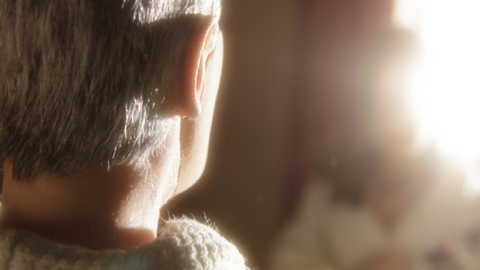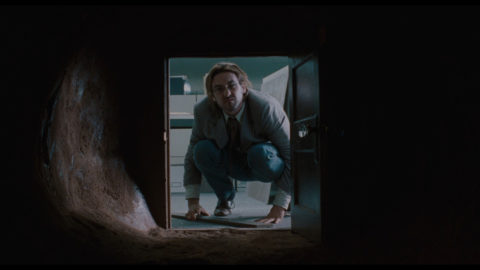Interview: Charlie Kaufman and Duke Johnson
Charlie Kaufman’s return to directing, accomplished with the help of animator Duke Johnson of Starburns Industries, unfolded for me as a kind of running joke on movie ideas: A customer-service guru named Michael walks into a hotel… Ten minutes pass, 20 minutes, 45… and he’s still there. That might not be especially unusual for your average real-world hotel visit, but the Hotel Fregoli (pronunciation recapped below by Kaufman) exists only in the mind of Kaufman, who chooses his setting, his wretched character Michael, his absurd conceit of voicing every other character with Tom Noonan except for David Thewlis as Michael and Jennifer Jason Leigh as his last chance at love (or a grip on reality)—and sticks with all of this.
That’s Anomalisa—or she’s Anomalisa, to be precise, the smitten customer-service rep named Lisa whom our (anti)hero meets while beating down doors in a hotel hallway. The raw, unexpurgated story that results, an “adult movie” of sorts (in Johnson’s words) in animated form, is some strange mating of Kaufmania (albeit sharing something with the resolutely, acrobatically ordinary milieus and neurotic psychological detail of David Foster Wallace, as in The Pale King) and clean yet surreal visuals that resemble an Academy Award-animated short writ large. Anomalisa is also off-putting at times, which has led to some divisive responses. But I would expect nothing less from a dark comedy that poses the choice between Michael being either desperate for love or clinically insane (or both).
Kaufman can be reserved in interviews with a sense of dry understatement—my conversation with him circa Synecdoche, New York years ago remains a source of chuckles for me—and he’s been reluctant to elucidate certain aspects of Anomalisa. But FILM COMMENT made an attempt at some questions about the film—which opens on December 30—while grabbing a few minutes of his and Johnson’s time last week.
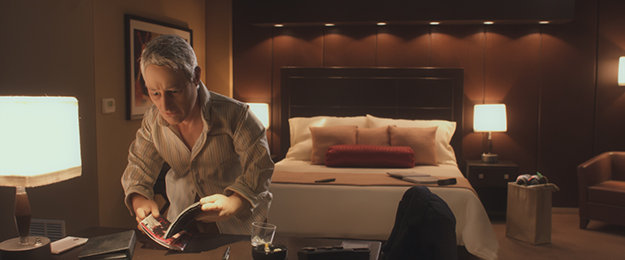
You’re in California now, so it’s hopefully not the end of a brutally long day for you.
Charlie Kaufman: No, it’s not. It is 3:18 p.m.
I have one question right off the bat, because I was a little confused when I looked at the credits and saw who the main character, Michael, was based on. I’d thought he was a dead ringer for the actor Victor Garber.
CK: [Laughs] Now that you mention that, I see that. That’s so funny. He is based on Duke’s ex brother-in-law. Who happens to be Victor Garber.
So what was the process, translating a face into a character?
CK: We had a sculptor named Carol Koch who looked at pictures of him and interpreted it into a clay maquette. So it’s funny that people think that Michael is photorealistic and looks exactly like a human, but he’s not really. His proportions are not exactly accurate, and there’s definitely some interpretation there.
One thing that I noticed is that his legs are maybe a little shorter proportionally than they might be.
CK: I think that’s a result of an illusion created by the fact that his head is a little bit larger.
I am looking at the wrong end.
CK: Potato, patato.
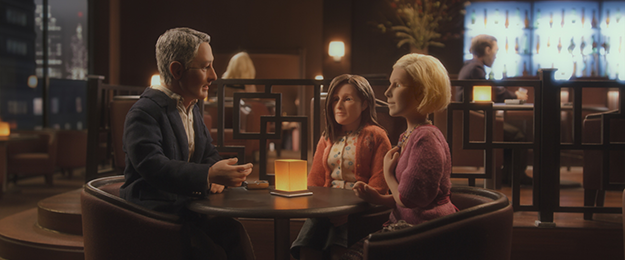
Duke, this was originally a radio script for a stage performance in 2005. I’m curious what about it made you think it could work as a film.
Duke Johnson: Well, really the person who had the idea for this to be established as a film was Dino Stamatopoulos. But Dino and I have talked over the years about taking stop-motion into the realm of more adult stories and adult situations—tell a real adult movie in this medium. I was a big fan of Charlie’s work so when Dino mentioned that he had a copy of the script as something that we could approach to Charlie about doing, I was super excited about it. I read the script and I loved it. I didn’t exactly know how it would translate into stop-motion, but… there was no “why not,” you know? This medium done right could be used to tell any story.
And, Charlie, when adapting it, what exactly did you change in the script?
CK: There weren’t really changes in dialogue—there were additions. It was taking something that was by definition non-visual and making it into something that was visual. There were visual jokes that were added; the whole visual design of the film; the blocking… All of the stuff was added afterwards because it was already dense. Dialogue—it was completely a dialogue-driven thing. We made some changes for economic reasons, and those were really the only changes that you hear. We couldn’t use Casablanca, we couldn’t afford it, for the movie that Michael is watching on TV, so we had to change it to My Man Godfrey because it was in the public domain. The song that Lisa sings in the play is “My Heart Will Go On,” Celine Dion. We couldn’t afford that so we got the Cyndi Lauper “Girls Just Want to Have Fun.” And there was something else: the name of the hotel was the Millennium, which is an actual hotel in Cincinnati. They wouldn’t allow us to use their name so we changed the name to Fregoli.
Right—how does the hotel clerk say it again?
CK: Fray-jo-li.
One thing I associate with your movies is finding new ways of visualizing these feelings and these ideas about point of view and subjectivity. So it is very interesting to me that it was a stage production in the first place.
CK: Yeah, but as a stage play, it was the same thing. It was a radio play, and I was trying to figure out how to use the form—which in this case was voices. That was where the idea of one character playing all these people [came from]—to sort of suggest someone’s inability to connect with other people. No matter what form I write in, I am always trying to figure out how to use that form to inspect the damage.
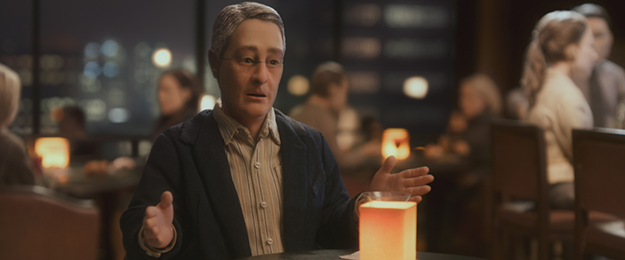
Having one voice almost felt like a way of translating a prose style. You know, you read a book, and everything is described or written in a certain style or voice, but we don’t think of the world and that book as being uniform. But in a stylistic way it is, you know what I mean?
CK: That’s interesting.
The sound design is a big part of the film too. The voices were recorded in advance of the animation being finished, right?
CK: Yeah, but that’s usually the way it’s done in animation. Because you use the voices to coordinate the faces and structure the dialogue. But I think the thing that we did that was unusual was that we had the actors all together. Usually they record the actors separately and get very, very clean takes. We recorded it as if it were a play—so the actors were interacting with each other, there is overlapping in the dialogue, and stuff like that. Which I think definitely adds to the tone of the finished product.
How many retakes were you doing with the voice recording? Or were you generally kind of giving people freedom?
CK: We rehearsed for a day and then we recorded for two full days. The dialogue is not that long… I don’t remember how we actually did it, but we took the whole time.
DJ: We would go through a scene and we maybe give an adjustment, a note, and go through the scene again. We kind of break it apart by scene, one scene at a time.
CK: And some of things that I just mentioned to you before, that ended up in the movie, were things that we had to come to on the fly. We didn’t have My Man Godfrey set up—we kept thinking we were going to be able to get the rights to this other thing. So while we were recording, we had to take that out, and Tom had to do it then. I think that “Girls Just Want to Have Fun” was also a last-minute decision. So those took a little bit more time, because those have never been rehearsed by the actors before.
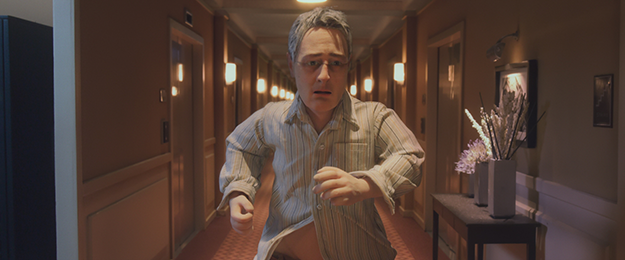
What was your association with Tom Noonan that led you to cast him originally in the stage version and again with this?
CK: I had seen Tom’s movie What Happened Was…
I love that one. He actually directed that, didn’t he?
CK: He directed it, and he wrote it and he’s one of the two people in it. And I had seen it, and I just loved that movie. I really responded to it, and it’s not something I normally do, but I wrote to him, because I found out that you could write to him on his website. And at this point I wasn’t established—I was working in TV as a writer, but I didn’t have any kid of name recognition—but I wrote him this letter telling him how much I loved his movie, and then he wrote back to me pretty quickly, probably within an hour and a half. A very nice letter, you know, a very decent kind of response and respectful, and I could appreciate it. So we had a bit of a correspondence, and I approached him. I can’t remember if I actually met with him. I might have met with him socially, but very infrequently, because he lives in New York and I don’t.
It’s interesting that it dates all the way back to when you were writing for TV. Actually, I remember interviewing you for Synecdoche, and we talked about your TV work. You were describing some pilots that you worked on, or came up with, and that you had some sort of Disney development deal. At one point they just wanted you to make a movie based on the title Astronuts or something?
CK: That’s correct. It was a pilot, and I did, I wrote it. I wrote the Astronuts and it was much better than the title, I think.
But it is interesting now that you come full circle now to doing an animated movie.
CK: Oh, Astronuts was going to be live action! Yeah, it was going to be like The Monkees, I think. And this is an animated movie, but we don’t think of it as a cartoon, you know? We think of it as: we wanted to make this movie, and this is the medium in which we made it. We feel like this is an adult movie.
Absolutely.
CK: Which happens to be done in this form of stop-motion.
What are some dark or serious animated films that come to mind that each of you like?
DJ: There’s a film called Mary and Max, which is a stop-motion film that deals with more adult themes that I like.
CK: I like Mary and Max too.
DJ: There’s a lot of Eastern European stuff, Svankmajer stuff, Quays stuff.
CK: What about Templeton? Suzie Templeton?
DJ: Suzie Templeton’s work we looked at, but for the most part our stylistic and creative approach to the movie was more like a traditional live-action film—with regard to lighting, camera work, and things like that. Certainly we have referenced other animations when we were figuring out some of the design stuff and how the puppets might function.
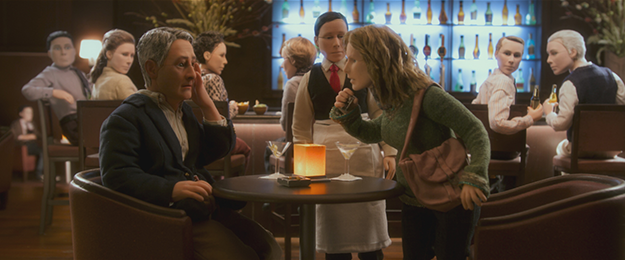
And just their look—everyone else reminded me of that Kids From the Hall actor Bruce McCulloch, but I doubt that was intentional.
DJ: How many people… That’s the one character where everybody feels like it is somebody that they know. That’s because it is kind of generic.
CK: The face is an amalgamation of everybody that worked at Starburns, in Photoshop. We were trying to get some generic, sort of androgynous face that could be used for men, women, and children.
DJ: Yes, so depending on what sort of wig you put on, you can change it a lot.
It really is an adult movie, and it’s even adult for so-called adult dramas. It’s a tough story—where basically the main character has to figure out whether he’s in love or he’s crazy. And on her side, at the end, depending on how you view it, she’s kind of mistaking his psychosis for true romance.
CK: Ummm…
I don’t know.
CK: I don’t know either. We make it a point not to explain.
Oh, I wasn’t necessarily looking for an explanation. But it’s pretty serious stuff—the notion of essentially being disassociated from yourself…
CK: You know, it’s interesting, because people look at the ending and have very different responses to it. And to Lisa at the end. Some people see it as hopeful, and some people see it, I think, as you suggested, as not hopeful. And I like that about it. I like to keep that alive.
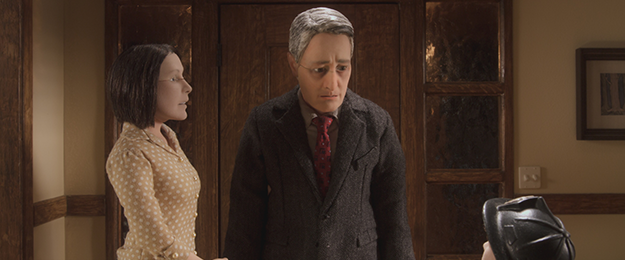
On her part I think it is hopeful. But on his part, it is hard to see where he goes from there. He even seems like he has some kind of history with his family from the way his wife reacts.
CK: Yeah, I think she… I think there have been some problems at home.
What are each of you going to be working on next? Or are you going to be working again together at any point?
DJ: We had talked about working together again and possibly on another animated film, should this film do well and provide the opportunity to do that. I think that we both enjoyed the experience of making this film and working together.
CK: There’s nothing specific in mind, but we have talked about that. And I personally am adapting a book to do a live-action film next. I’m rewriting a script that I wrote for a studio, and I’m working on a novel.



